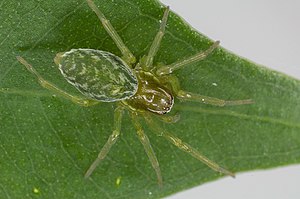Green curled spider
| Green curled spider | ||||||||||
|---|---|---|---|---|---|---|---|---|---|---|

Green curled spider (female) |
||||||||||
| Systematics | ||||||||||
|
||||||||||
| Scientific name | ||||||||||
| Nigma walckenaeri | ||||||||||
| ( Roewer , 1951) |
The green curling spider ( Nigma walckenaeri ), also known as the green lurking spider, is a species of spider from the family of curling spiders (Dictynidae). The species is unmistakable in Central Europe because of its green color.
features
The green curly spider reaches a body length of 3.5 to 5 mm, making it the largest species of the family in Central Europe. The front body ( prosoma ) of the females is monochrome light green to greenish beige. It shows a U-shaped drawing formed by light hair that opens to the front.
The rear part of the body ( opisthosoma ) is usually bright green in one color, but can also have whitish or yellow spots. Especially on the sides it shows white hair arranged in narrow bands. The legs are also solid green.
In the male, the head region is significantly increased. Furthermore, the prosoma and legs are yellow-brown.
distribution and habitat
The warmth-loving species inhabits a relatively small area in the southwestern Palearctic from Great Britain and Portugal to the east to Iraq and from Germany to the south to North Africa. The species is absent in Ireland , Scandinavia and the Baltic States . The distribution area includes the temperate to subtropical zone. In Germany the species is restricted to heat-favored areas as well as urban areas and is absent in the northwest.
The species inhabits sunny forest edges in southern Europe, but in Germany it can be found almost exclusively in settlement areas. It mainly inhabits house walls overgrown with ivy or wild grapevine, and more rarely large-leaved shrubs, e.g. B. Lilac .
Way of life
The green curl spider builds a tent-shaped, translucent web of living space on top of larger leaves, the sides of which are curved upwards. The network is usually located at the base of the leaf and is open at the bottom. The spider is very well camouflaged there due to its color. From the opening, catch threads are laid in a zigzag shape over the leaf blade, in which even very large insects such as medium-sized flies can get caught.
Sexually mature animals appear from August to October, and they can still be found on buildings in December. For copulation, the female grasps the chelicerae of the male, which then alternately introduces its pedipalps into the sexual opening ( epigyne ) of the female. The lenticular egg cocoon is hidden in the vegetation.

Danger
The species is rare in Germany. Overall, a hazard is assumed, but a classification into a hazard category is dispensed with. In Brandenburg and Berlin it is common in suitable habitats and is considered safe.
Individual evidence
- ↑ Michael J. Roberts : Spiders of Britain and Northern Europe . 1st edition. Collins Field Guide, 1996, ISBN 0-00-219981-5 (Over 450 Species).
- ^ Map of the worldwide distribution of the green curly spider from the British Arachnological Society
- ^ Atlas of the arachnids of Europe: evidence from Nigma walckenaeri
literature
- Heiko Bellmann : Cosmos Atlas Arachnids of Europe . 3rd edition, Kosmos, Stuttgart 2006 ISBN 978-3-440-10746-1 .
- Ralph Platen, Bodo von Broen, Andreas Herrmann, Ulrich M. Ratschker, Peter Sacher: Total species list and red list of spiders, harvestmen and pseudoscorpions of the state of Brandenburg (Arachnida: Araneae, Opiliones, Pseudoscorpiones) with information on frequency and ecology. Nature conservation and landscape management in Brandenburg 8, booklet 2 (supplement); 1999.
- Dick Jones: The Cosmos Spider's Guide. Kosmos, 1990, ISBN 3-440-06141-8
Web links
Green curly spider in the World Spider Catalog
- Nigma walckenaeri at Fauna Europaea

